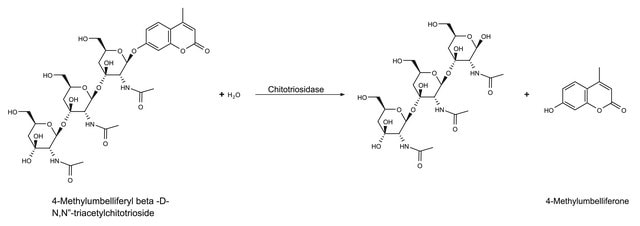CS1030
Chitinase Assay Kit, Fluorimetric
sufficient for 200 multiwell tests
Synonym(s):
Chitinase Detection Kit
About This Item
Recommended Products
usage
sufficient for 200 multiwell tests
Quality Level
shipped in
wet ice
storage temp.
−20°C
Gene Information
human ... CHIT1(1118)
General description
Application
- 4-Methylumbelliferyl N,N′-diacetyl-β-D-chitobioside - substrate suitable for exochitinase activity detection (chitobiosidase activity)
- 4-Methylumbelliferyl N-acetyl-β-D-glucosaminide - substrate suitable for exochitinase activity detection (β-N-acetylglucosaminidase activity)
- 4-Methylumbelliferyl β-D-N,N′,N′′-triacetylchitotriose - substrate suitable for endochitinase activity detection
Biochem/physiol Actions
The chitinolytic enzymes are also categorized based on their enzymatic action on chitin substrates. Endochitinases are defined as the enzymes catalyzing the random cleavage at internal points in the chitin chain. Exochitinases catalyze the progressive release of acetylchitobiose or N-acetylglucosamine from the non-reducing end of chitin, and are referred to as chitobiosidase and β-N-acetylglucosaminidase, respectively.
Chitinases perform different functions in different organisms. In bacteria, they are mainly involved in nutritional processes. In yeast and various fungi, these enzymes participate in morphogenesis. In animals and plants, chitinases primarily play a role in the defense of the organism against pathogen attack.
Suitability
Preparation Note
Kit Components Only
- Assay Buffer 25 mL
- 4-Methylumbelliferyl N-acetyl-β-D-glucosaminide 5 mg
- 4-Methylumbelliferyl β-D-N,N′-diacetylchitobioside hydrate 5 mg
- 4-Methylumbelliferyl β-D-N,N′,N′′-triacetylchitotriose 5 mg
- Chitinase from Trichoderma viride 1 mg
- 4-Methylumbelliferone Standard Solution, 50 mg/mL 1 mL
- Sodium Carbonate 2 g
- Dimethyl Sulfoxide 1 mL
Signal Word
Danger
Hazard Statements
Precautionary Statements
Hazard Classifications
Eye Irrit. 2 - Resp. Sens. 1
Storage Class Code
10 - Combustible liquids
Flash Point(F)
Not applicable
Flash Point(C)
Not applicable
Regulatory Listings
Regulatory Listings are mainly provided for chemical products. Only limited information can be provided here for non-chemical products. No entry means none of the components are listed. It is the user’s obligation to ensure the safe and legal use of the product.
PDSCL
Please refer to KIT Component information
PRTR
Please refer to KIT Component information
FSL
Please refer to KIT Component information
ISHL Indicated Name
Please refer to KIT Component information
ISHL Notified Names
Please refer to KIT Component information
Cartagena Act
Please refer to KIT Component information
JAN Code
キットコンポーネントの情報を参照してください
Certificates of Analysis (COA)
Search for Certificates of Analysis (COA) by entering the products Lot/Batch Number. Lot and Batch Numbers can be found on a product’s label following the words ‘Lot’ or ‘Batch’.
Already Own This Product?
Find documentation for the products that you have recently purchased in the Document Library.
Customers Also Viewed
Our team of scientists has experience in all areas of research including Life Science, Material Science, Chemical Synthesis, Chromatography, Analytical and many others.
Contact Technical Service









